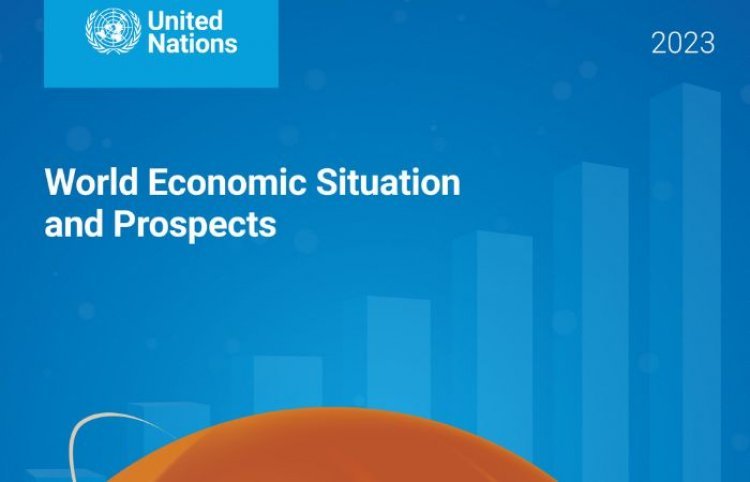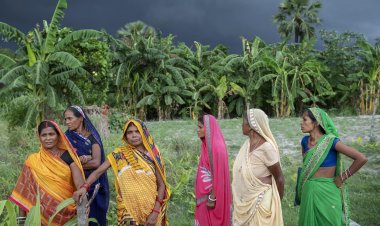World economy battered in 2022; India’s GDP growth rate to moderate to 5.8 pc in 2023: UN report
A series of severe and mutually reinforcing shocks — the Covid-19 pandemic, the war in Ukraine and resulting food and energy crises, surging inflation, debt tightening as well as the climate emergency — battered the world economy in 2022. World output growth is projected to decelerate from an estimated 3.0 per cent in 2022 to 1.9 per cent in 2023, marking one of the lowest growth rates in recent decades, according to the United Nations WESP 2023. As for India, while the UN projected a growth of 6 per cent in the fiscal year 2022-23 and 6.2 per cent in 2023-24, it has lower projections on a calendar year basis.

A series of severe and mutually reinforcing shocks — the Covid-19 pandemic, the war in Ukraine and resulting food and energy crises, surging inflation, debt tightening as well as the climate emergency — battered the world economy in 2022. Against this backdrop, world output growth is projected to decelerate from an estimated 3.0 per cent in 2022 to 1.9 per cent in 2023, marking one of the lowest growth rates in recent decades, according to the United Nations World Economic Situation and Prospects (WESP) 2023, launched on Wednesday.
The report said, “Economic growth in India is projected to moderate in 2023 (calendar year), with higher interest rates weighing on investment and slower global growth weakening exports.” While the UN projected a growth of 6 per cent in fiscal year 2022-23 and 6.2 per cent in 2023-24, it has lower projections on a calendar year basis.
Gloomy economic outlook
Overall, the report presents a gloomy and uncertain economic outlook for the near term. Global growth is forecast to moderately pick up to 2.7 per cent in 2024 as some of the headwinds will begin to subside. However, this is highly dependent on the pace and sequence of further monetary tightening, the course and consequences of the war in Ukraine, and the possibility of further supply-chain disruptions.
The tepid global economic prospects also threaten the achievement of the 17 Sustainable Development Goals (SDGs), when the 2023 SDG Summit in September marks the mid-point of the implementation of the 2030 Agenda.
“This is not the time for short-term thinking or knee-jerk fiscal austerity that exacerbates inequality, increases suffering and could put the SDGs farther out of reach. These unprecedented times demand unprecedented action,” said António Guterres, United Nations Secretary-General. “This action includes a transformative SDG stimulus package, generated through the collective and concerted efforts of all stakeholders,” he added.
The report presented a gloomy economic outlook for both developed and developing economies.
Prospects of a recession
Amid high inflation, aggressive monetary tightening and heightened uncertainties, the current downturn has slowed the pace of economic recovery from the Covid-19 crisis, threatening several countries — both developed and developing — with the prospects of a recession in 2023. Growth momentum significantly weakened in the United States (US), the European Union (EU) and other developed economies in 2022, adversely impacting the rest of the global economy through a number of channels.
Tightening global financial conditions coupled with a strong dollar exacerbated fiscal and debt vulnerabilities in developing countries. Over 85 per cent of central banks worldwide tightened monetary policy and raised interest rates in quick succession since late 2021, to tame inflationary pressures and avoid a recession. Global inflation, which reached a multi-decade high of about 9 per cent in 2022, is projected to ease but remain elevated at 6.5 per cent in 2023.
Most developing countries have seen a slower job recovery in 2022 and continue to face considerable employment slack. Disproportionate losses in women’s employment during the initial phase of the pandemic have not been fully reversed, with improvements mainly arising from a recovery in informal jobs.
According to the report, slower growth, coupled with elevated inflation and mounting debt vulnerabilities, threatens to further set back hard-won achievements in sustainable development, deepening the already negative effects of the current crises. Already in 2022, the number of people facing acute food insecurity had more than doubled compared to 2019, reaching almost 350mn. A prolonged period of economic weakness and slow income growth would not only hamper poverty eradication but also constrain countries’ ability to invest in the SDGs more broadly.
“The current crises are hitting the most vulnerable the hardest — often through no fault of their own. The global community needs to step up joint efforts to avert human suffering and support an inclusive and sustainable future for all,” said Li Junhua, United Nations Under-Secretary-General for Economic and Social Affairs.
Govts should avoid fiscal austerity
The report calls for Governments to avoid fiscal austerity which would stifle growth and disproportionately affect the most vulnerable groups, affect progress in gender equality and stymie development prospects across generations. It recommends reallocation and reprioritization of public expenditures through direct policy interventions that will create jobs and reinvigorate growth. This will require strengthening social protection systems and ensuring continued support through targeted and temporary subsidies, cash transfers, and discounts on utility bills, which can be complemented with reductions in consumption taxes or customs duties.
Strategic public investments in education, health, digital infrastructure, new technologies and climate change mitigation and adaptation can offer large social returns, accelerate productivity growth, and strengthen resilience to economic, social and environmental shocks.
Additional SDG financing needs in developing countries vary by source but are estimated to amount to a few trillion dollars per year. Stronger international commitment is urgently needed to expand access to emergency financial assistance; to restructure and reduce debt burdens across developing countries; and to scale up SDG financing.
The outlook for South Asia has deteriorated and is subject to multiple downside risks amid global monetary tightening, fiscal vulnerabilities, rising inflation and extreme weather events. Regional GDP growth is expected to slow to 4.8 per cent in 2023 from an estimated 5.6 per cent expansion in 2022. Overall, weaker global demand, tighter monetary policy, additional supply disruptions, further escalation in commodity prices and the emergence of new Covid‐19 variants pose significant risks in 2023.
Growth in India is projected to moderate
Coming to India, the UN report did raise caution over its rising interest burden due to its debt levels and rising interest rates. On the employment front, it stated that although the overall unemployment rate is at a multi-year low, concerns remain over unemployment among the youth and especially among young women.
“Economic growth in India is projected to moderate in 2023 (calendar year), with higher interest rates weighing on investment and slower global growth weakening exports,” the report read.
While the UN projected growth of 6 per cent in fiscal year 2022-23 and 6.2 per cent in 2023-24, it has lower projections on a calendar year basis.
“India’s GDP growth rate is projected to moderate to 5.8 per cent in 2023 from an estimated 6.4 per cent in 2022 as higher interest rates and a global economic slowdown will weigh on investment and export performance,” the report said.
Regarding the unemployment rate, the report noted that it had “dropped to a four-year low of 6.4 per cent in India as the economy added jobs both in urban and rural areas in 2022”.
The report added that in India, the unemployment rate in 2022 declined to pre-pandemic levels through stepped-up urban and rural employment. “But youth employment remained below pre-pandemic levels, particularly among young women, given the pandemic’s severe impacts on economic sectors where women tend to cluster.”
Modest recovery of growth in China
Growth in China is projected to moderately improve in 2023 after a weaker-than-expected performance in 2022. Amid recurring Covid‐19-related lockdowns and prolonged stress in the real estate market, the economy expanded by only 3 per cent in 2022. With the Government abandoning its zero-Covid‐19 policy in late 2022 and easing monetary and fiscal policies, economic growth is forecast to accelerate to 4.8 per cent in 2023. But the reopening of the economy is expected to be bumpy. Growth will likely remain well below the pre-pandemic rate of 6 to 6.5 per cent.
Economic recovery in East Asia remains fragile, although average growth is stronger than in other regions. In 2023, GDP growth in East Asia is forecast to reach 4.4 per cent, compared to 3.2 per cent in 2022, mainly reflecting the modest recovery of growth in China.








































